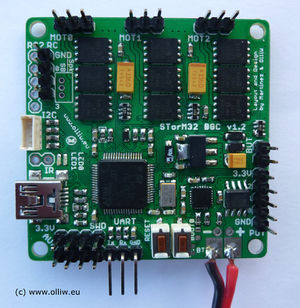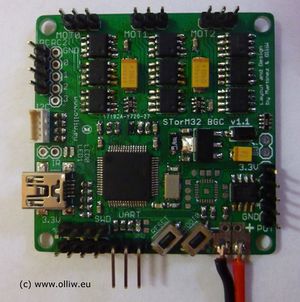STorM32 Boards: Difference between revisions
No edit summary |
No edit summary |
||
| Line 55: | Line 55: | ||
* only 2 auxiliary ports | * only 2 auxiliary ports | ||
{{COMMENT|{{WARNING|'''The order of pins on the I2C#2 port is reversed to that on the I2C#1 port'''}}; please consider this then connecting a MPU module to the I2C#2 port.}} | {{COMMENT|{{WARNING|'''The order of pins on the I2C#2 port is reversed to that on the I2C#1 port'''}}; | ||
please consider this then connecting a MPU module to the I2C#2 port. Verify voltage polarity when connecting MPU }} | |||
<br clear="all" /> | <br clear="all" /> | ||
Revision as of 21:11, 18 February 2015
The technical specifications of various STorM32 boards are presented.
For suppliers/vendors please refer to Where to buy STorM32 boards. For a detailed description of the various connectors on the boards see Pins and Connectors.
Comment: To avoid confusion or misunderstandings please note: The boards may provide features hardware-wise which are not yet supported by the firmware. Please check the firmware description to find out (see e.g. the project page).
"Original" STorM32 Boards
At present, the versions v1.1, v1.2, and v1.3 are in use (v0.17/v1.0 boards are deprecated). Their commonality is a resistive voltage regulator and the TC4452 motor drivers.
Comments:
- The boards can be populated with different motor drivers, namely TC4452 driver in DFN package or TC4452 driver in SOIC package; the DFN package allows somewhat higher motor currents.
- The boards can in principle be populated with different micro controllers; the standard configuration is a STM32F103RC.
STorM32-BGC v1.3
|
|
STorM32-BGC v1.2
Differences to the v1.3 board:
- voltage regulator: smaller SOT223 package
- only 2 auxiliary ports
STorM32-BGC v1.1
Differences to the v1.3 board:
- no Futaba S-bus support
- Spektrum satellite is supported, but no extra Spektrum connector on board
- no extra USB voltage protection diode
- voltage regulator: smaller SOT223 package
- only 2 auxiliary ports
Comment: The order of pins on the I2C#2 port is reversed to that on the I2C#1 port; please consider this then connecting a MPU module to the I2C#2 port. Verify voltage polarity when connecting MPU
Descendants
The STorM32 boards listed here are based on/derived from the layout of the "original" board designed by Martinez and OlliW, but modified in some ways.
GLB STorM32 v1.31
|
|



